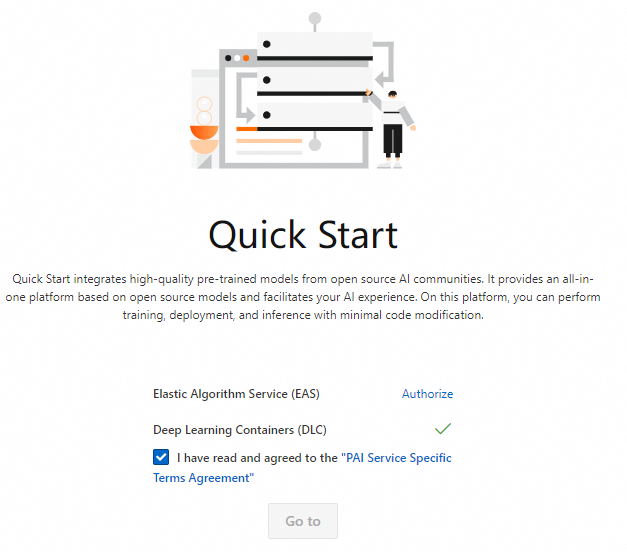QuickStart is a component of Platform for AI (PAI) that integrates high-quality pre-trained models from open source AI communities. QuickStart allows you to train and deploy open source models and use the models for inference without coding. This helps you use AI technologies in a faster, more efficient, and more convenient manner.
Limits
QuickStart is supported only in the following regions: China (Beijing), China (Shanghai), China (Hangzhou), and China (Shenzhen).
Features
QuickStart supports the following pre-trained models:
AI-generated content (AIGC) models
Text-to-image generation, large language model (LLM), and image captioning models
Computer vision models
Image classification, object detection, video classification, image segmentation, image generation, and optical character recognition (OCR) models
Natural language processing (NLP) models
Text classification, sequence labeling, text generation, zero-shot classification, and text vectorization models
Speech models
Speech recognition, speaker verification, and speech separation models
QuickStart supports the following features:
Model deployment with a few clicks, fine-tuning, incremental training, and online debugging
Custom configurations for advanced users, such as hyperparameter configuration
Billing
QuickStart is free to use. However, you are charged for the resources that you use to train or deploy models in QuickStart. For more information, see Billing of QuickStart.
Permissions
No additional authorization is required to use QuickStart. Permissions on related resources must be granted if you use QuickStart to train or deploy models.
If you use QuickStart to train models, an Object Storage Service (OSS) bucket is used to store datasets and model training result files, and Deep Learning Containers (DLC) is used to run training jobs. Therefore, permissions on OSS and DLC must be granted. For more information, see Grant the permissions that are required to use DLC.
If you use QuickStart to deploy models, Elastic Algorithm Service (EAS) is used to run deployment jobs. Therefore, permissions on EAS must be granted. For more information, see Grant the permissions that are required to use EAS.
Enable QuickStart
Go to the QuickStart page.
Log on to the PAI console.
In the left-side navigation pane, click Workspaces. On the Workspaces page, find the workspace that you want to manage and click the name of the workspace. The Workspace Details page appears.
In the left-side navigation pane of the Workspace Details page, click QuickStart.
On the QuickStart page, select I have read and agreed to the Machine Learning Platform for AI Terms of Service and click Go to.

Use QuickStart
The following figure shows the process of training and deploying models in QuickStart.

On the QuickStart page, find a model that is suitable for your business. For more information, see the "Find a model that is suitable for your business" section of the Deploy and train models topic.
QuickStart allows you to directly deploy a pre-trained model as an online service. Then, you can debug the service online and check whether the inference results meet your business requirements. For more information, see the "Deploy and debug a model" section of the Deploy and train models topic.
If the inference results of the model do not meet your business requirements, you can fine-tune the model by using your own dataset for better results. You can also deploy the fine-tuned model as a model service to use the model in your business. For more information, see the "Fine-tune a model" section of the Deploy and train models topic.
You can incrementally train your model to continuously iterate the model to meet the latest changes in your business requirements. For more information, see the "Incrementally train a model" section of the Deploy and train models topic.